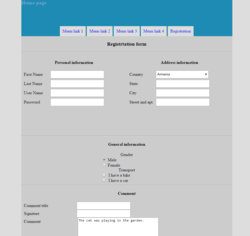The shell path for a user in macOS or OSX is a set of locations in the filing system whereby the user has permissions to use certain applications, commands and programs without the need to specify the full path to that command or program in the Terminal. This will work in macOS Mojave, Sierra and all older OSX operating systems; El Capitan, Yosemite, Mavericks and Lion.
So instead of running something like this, with a path to the command:
You can just type the command, regardless of where you are in the filing system:
Install Gulp globally. Launch your Terminal app and install gulp globally. Sudo npm install gulp-cli -g.
Your shell path is a bunch of absolute paths of the filing system separated by colons :
You can find out whats in your path by launching Terminal in Applications/Utilities and entering:

- It will display the installed Node.js version. Npm -v Step 6 − In the command prompt, enter the following command to install Gulp. Adding “-g” flag ensures that the Gulp is globally available for any project. Npm install gulp -g Step 7 − To verify that Gulp has been installed successfully, enter the following command to display the Gulp.
- This step by step tutorial shows how to install on Node.js and NPM (Node Package Manager) on your Mac computer.
- A QR-code based, Google Cloud Function hosted, Slack integrated Door bell!
- Use /etc/paths.d/ directory via the pathhelper tool to generate the PATH variable for all user accounts on the system. This method only works on OS X Leopard and higher.
And the result should be like this…
So this is stating that you can run Unix style applications or commands located in 5 default locations of a certain path in the filing system:
- /usr/bin
- /bin
- /usr/sbin
- /sbin
- /usr/local/bin
These directories are not visible by default in the filing system but you can make them visible.
Adding a Temporary Location
You can add extra locations to your path, in the mysql example above it’s location /usr/local/mysql/bin which is not in the default path, you can add it in Terminal like so:
So here I have copied my existing path and added the new location on the end. Test it by running echo $PATH again in the Terminal.
One of the disadvantages of this is that the new location will only be honored for that particular Terminal session, when a new Terminal window is launched it will have the original default path again.
Adding in a Permanent Location
To make the new pathstick permanently you need to create a .bash_profile file in your home directory and set the path there. This file control various Terminal environment preferences including the path.
Move into home directory
Create the .bash_profile file with a command line editor called nano

Add in the above line which declares the new location /usr/local/mysql/bin as well as the original path declared as $PATH.
Save the file in nano by clicking ‘control’ +’o’ and confirming the name of the file is .bash_profile by hitting return. And the ‘control’+’x’ to exit nano
How To Fix 24path For Gulp Node On Mac Air
So now when the Terminal is relaunched or a new window made and you check the the path by
You will get the new path at the front followed by the default path locations, all the time

Rearranging the default $PATH
If you needed to rearrange the paths in the default $PATH variable, you can just do that and leave off $PATH.
So lets say you want /use/local/bin at the beginning to take precedence you can add the default path like so inside .bash_profile
And then you can slot in other paths as required.
The shell path for a user in macOS or OSX is a set of locations in the filing system whereby the user has permissions to use certain applications, commands and programs without the need to specify the full path to that command or program in the Terminal. This will work in macOS Mojave, Sierra and all older OSX operating systems; El Capitan, Yosemite, Mavericks and Lion.
So instead of running something like this, with a path to the command:
You can just type the command, regardless of where you are in the filing system:
Your shell path is a bunch of absolute paths of the filing system separated by colons :
You can find out whats in your path by launching Terminal in Applications/Utilities and entering:
And the result should be like this…
So this is stating that you can run Unix style applications or commands located in 5 default locations of a certain path in the filing system:
- /usr/bin
- /bin
- /usr/sbin
- /sbin
- /usr/local/bin
These directories are not visible by default in the filing system but you can make them visible.

How To Fix 24path For Gulp Node On Mac Catalina
Adding a Temporary Location
You can add extra locations to your path, in the mysql example above it’s location /usr/local/mysql/bin which is not in the default path, you can add it in Terminal like so:
So here I have copied my existing path and added the new location on the end. Test it by running echo $PATH again in the Terminal.
One of the disadvantages of this is that the new location will only be honored for that particular Terminal session, when a new Terminal window is launched it will have the original default path again.
Adding in a Permanent Location
To make the new pathstick permanently you need to create a .bash_profile file in your home directory and set the path there. This file control various Terminal environment preferences including the path.
Move into home directory
Create the .bash_profile file with a command line editor called nano
How To Fix 24path For Gulp Node On Mac Drive
Add in the above line which declares the new location /usr/local/mysql/bin as well as the original path declared as $PATH.
Save the file in nano by clicking ‘control’ +’o’ and confirming the name of the file is .bash_profile by hitting return. And the ‘control’+’x’ to exit nano
So now when the Terminal is relaunched or a new window made and you check the the path by
How To Fix 24path For Gulp Node On Mac Os
You will get the new path at the front followed by the default path locations, all the time
Rearranging the default $PATH
If you needed to rearrange the paths in the default $PATH variable, you can just do that and leave off $PATH.
So lets say you want /use/local/bin at the beginning to take precedence you can add the default path like so inside .bash_profile
And then you can slot in other paths as required.



